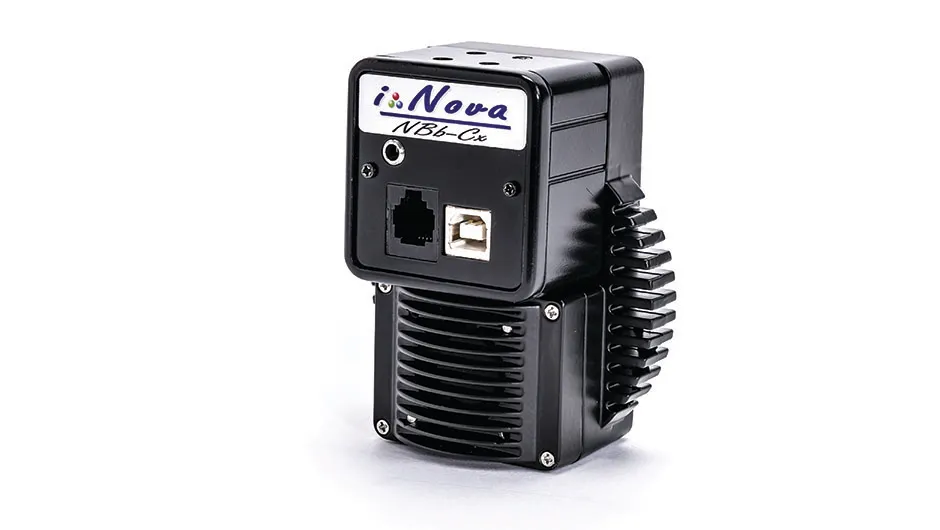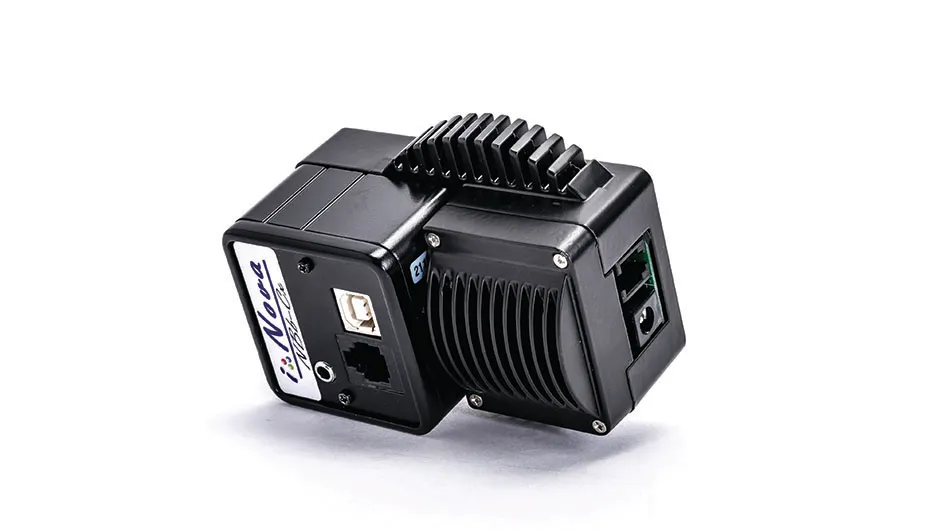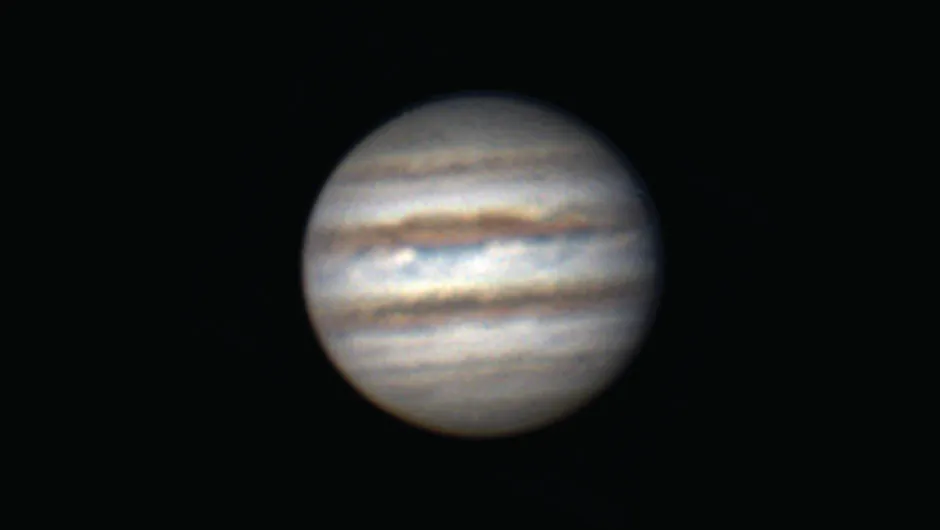The iNova NBB-Cx colour camera blurs the line between planetary and deep-sky imaging, which for a long time have been regarded as two distinct disciplines.
There are a number of cameras already on the market that can be used to image both, but the NBB-Cx goes the extra mile by including active cooling to reduce noise and produce optimised results.
The phrase ‘Solar System imaging’ describes the processes required to capture images of the Sun, Moon and brighter planets.
These targets are relatively bright, but suffer because the fine detail they present is at the mercy of the Earth’s turbulent atmosphere and easily lost.
Planetary cameras such as the NBB-Cx address this issue by taking lots of short exposure still images in a short burst.
By picking out the best frames, then aligning and stacking them, its possible to remove noise.
The smoother end result is then suitable for further processing to bring the best out of the image.The NBB-Cx is great at this.

Its capture software, PLxCapture, offers a dedicated planetary imaging module capable of capturing 8- or 12-bit images with exposures between one and 1,000 milliseconds.
The camera’s Aptina MT9M034 sensor has a 1280x960 pixel array, which is ideal for capturing large areas of the Moon or Sun.
At full array size, the camera is capable of delivering 8-bit frames at 30 frames per second (fps).
A planet’s disc will typically occupy a small part of the imaging field, and so the camera allows you to select a region of interest (ROI), using a smaller portion of the sensor.
A smaller pixel array means less data and consequently a higher frame rate – and capturing more frames per second gets your more from periods of steadier seeing.
The smallest ROI of 320x240 pixels can be delivered at 200fps.

Colouring the night
Our lunar imaging session produced excellent results despite the Moon’s low altitude at the time, with post processing revealing some fine detail.
An early morning session on Jupiter showed off the colour capabilities of the camera, the red-brown Southern and Northern Equatorial Belts contrasting beautifully with the exquisite grey-blue of a large equatorial festoon.
When you’re done imaging Solar System objects, the NBB-Cx can turn its hand to deep-sky targets.
Here, the requirements of the camera change somewhat: the very short exposures needed for planetary work are replaced with long exposures necessary to record faint detail in nebulae and galaxies.
Our first test sequence was on the Orion Nebula, M42.
We captured some great detail using a 4-inch f/9 telescope and modest exposures of 30 seconds and 120 seconds.
The results showed plenty of red too, which is an important component colour of emission nebulae.
Star colours were generally excellent as well; we managed to image bright Aldebaran in Taurus with its distinct orange hue intact.
The camera’s operating software is supplied on a USB memory stick and includes all you need to get the device working. Installation is straightforward but it pays to read and follow the initial instructions carefully.
Camera control is via PLxCapture, which offers separate interfaces for planetary imaging, deep-sky imaging and visual enhancement.
The design of each interface is reassuringly similar. Each presents two windows, one for control and one showing a preview of what the camera is seeing.
There are various noise reduction optimisations available with this camera, and they all work at their best when using PLxCapture’s visual enhancement module.
This is designed to create the cleanest images by stacking them in real time.
The visual enhancement module also includes its own autoguiding functions.
This camera performed well for us and was fun to use.
It’s a decent planetary imager and certainly capable of taking some great deep-sky images, especially when coupled with a short focal length wide-field scope.
If you’re just starting out, its main attraction is that it covers two bases in one device.
The use of similar looking controls for both disciplines is a big plus point too.
Finally, the addition of autoguiding functions means that should you upgrade in the future, the NBB-Cx still has a valuable place in your equipment toolbox.

A cold-hearted beast
The NBB-Cx camera has a number of optimisations to help improve image quality.
For a start, the thermoelectric cooling (TEC) unit uses a Peltier circuit and a cooling fan to achieve a temperature at least 25°C below ambient levels.
Cooling fins on the camera body speed up heat removal and these get appreciably warm to the touch quite quickly.
The sensor cooling makes a noticeable difference to the thermal noise present in images, something that increases as you up the exposure time.
In addition, during long-exposure sessions, non-essential components inside the camera are powered down, further reducing sources of heat and delivering images that are less noisy as a result.
Another unwanted noise source, known as readout noise, occurs every time an image is read off the sensor and pixel charge converted to a digital value.
The NBB-Cx camera helps reduce the effects of readout noise by providing different sensor readout speeds for its imaging modes.
Finally, the visual enhancement deep-sky imaging module produces the cleanest long-exposure images by incorporating real-time stacking to average out random noise.

Image sensor
Light is recorded by an Aptina MT9M034 CMOS colour sensor with a full array of 1280x960, 3.75μm pixels.
The chip’s quantum efficiency is good across visible wavelengths (red 57 per cent, green 62 per cent, blue 51 per cent); quantum efficiency being a measure of how much incoming light is actually recorded.
It can also be 2x2 binned for greater sensitivity.
An infrared-blocking filter is pre-fitted.
Autoguiding port
As well as its imaging capabilities, the iNova NBB-Cx can be used for autoguiding.
An RJ12 ST-4 cable (not supplied) is required to connect the camera to a compatible mount.
An ASCOM driver allows the camera to work with a number of commercial packages as well as popular freeware programs.

Communications port
The communications port at the base of the camera can be used to control other equipment via the ASCOM platform.
Control can then be applied via the PLxCapture software for equipment such as electric focusers, motorised filter wheels and GPS units.
PLxCapture software
The camera is controlled via PLxCapture.
On start up this presents four clickable areas, giving access to the Solar System, deep-sky and visual enhancement interfaces; a fourth pane exits the program.
Each interface is similar in appearance offering settings appropriate to what you’re imaging.
The visual enhancement module stacks deep-sky images in real time.
C-mount/1.25-inch fitting
The camera is pre-threaded with a C-mount thread, a standard often used for video cameras.
A C-mount to 1.25-inch eyepiece adaptor is supplied as standard.
This review originally appeared in the January 2015 issue of BBC Sky at Night Magazine.

